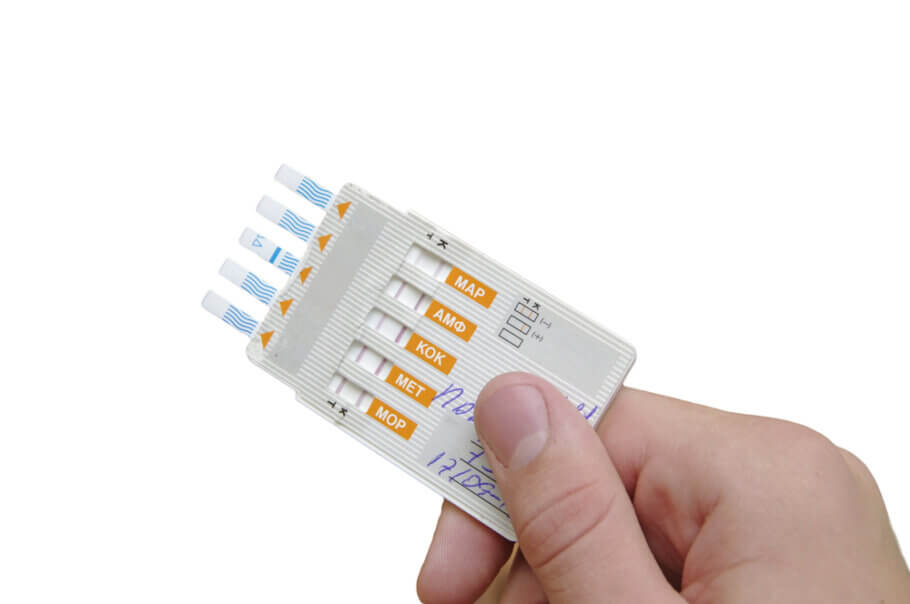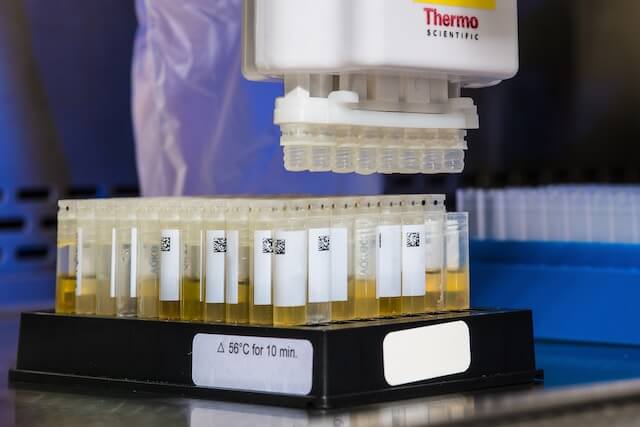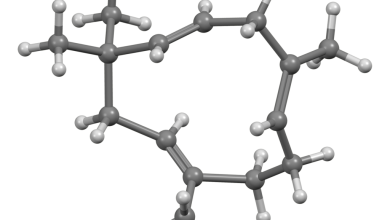The revealing metabolite of cannabis consumption- Alchimia Grow Shop
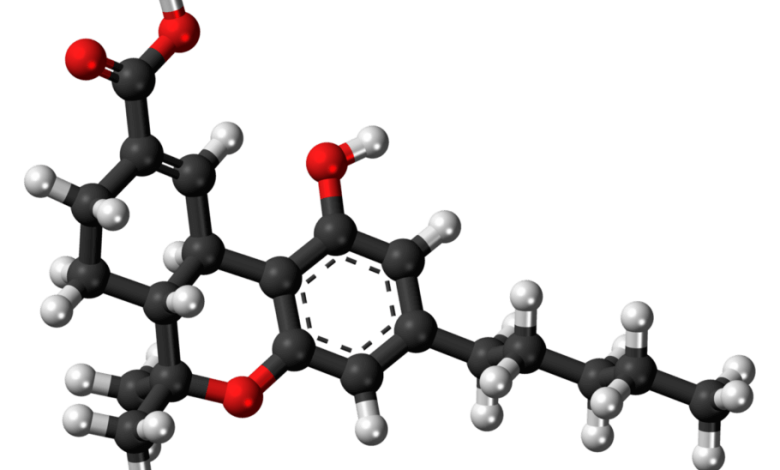
In the universe of cannabis-related compounds, THC (tetrahydrocannabinol) is widely known as the main responsible for the psychoactive effects that make this plant so iconic. However, in science and in cannabis consumption detection analyses, another compound takes center stage: THC-COOH (11-nor-9-carboxy-THC). This metabolite is a key indicator that reveals a user’s exposure to cannabis and has become an invaluable tool in medicine, toxicology, and law enforcement.
In this article, we will explore the role of THC-COOH in depth, from how it is formed in the body after cannabis use, to its importance in drug testing and its persistence in the body. We will discover how this metabolite has influenced drug policies and played a crucial role in decision-making in the medical and legal fields. Join us on a journey of knowledge about one of the most discussed and debated compounds in the world of cannabis and science.
What is THC-COOH?
THC-COOH – or 11-nor-9-carboxy-THC – is a metabolite of tetrahydrocannabinol (THC), present in many varieties of cannabis. Unlike THC, which is formed in the plant’s glandular trichomes, THC-COOH is formed in the body after THC ingestion and is widely used in cannabis screening tests due to its long persistence in the body. Thus, this molecule is a key marker for THC exposure and plays an essential role in medicine, toxicology, and law enforcement related to marijuana use.
Drug tests: what they are and how they work
Today we are going to delve into the tests that are usually used to track drugs in the body, tests that are increasingly common in different areas of our lives. What types of toxicological analyzes are there? Which are the most used and for what? Are they really reliable? How long do drugs last in the body before being undetectable by these tests? In this article you will find all the answers.
This compound was first identified in 1969 by forensic chemist and cannabis research pioneer Dr. Paul L. Cary. Dr. Cary played a key role in the development of cannabis screening tests and was one of the first scientists to investigate THC metabolites in the human body. His work was instrumental in understanding and detecting THC exposure through screening methods such as urine and blood testing.
THC and urine tests – How to pass them?
Urine tests are widely used to detect THC, the main psychoactive component of cannabis. These tests look for THC metabolites in the urine, indicating recent use. However, it is important to note that the results can be positive even weeks after consumption, raising questions about privacy and individual rights. Today we tell you everything about this type of test.
How is THC-COOH metabolized?
We have already seen that THC-COOH is formed in the body through a metabolism process, but… how exactly does this process happen? Below we detail step by step how THC is metabolized into THC-COOH in your body:
- THC ingestion: The process begins when a person consumes cannabis, whether by smoking it, vaporizing it, ingesting it, or in some other way. THC is the predominant psychoactive compound in cannabis, and is responsible for the psychotropic effects it produces.
- Absorption: Once THC is ingested, it is absorbed through the lungs (in the case of inhalation) or the gastrointestinal tract (in the case of ingestion) and enters the bloodstream.
- Distribution: THC is transported throughout the body through the blood, allowing it to reach the receptors of the endocannabinoid system in different tissues and organs, including the brain.
- Metabolism in the liver: The main pathway of THC metabolism occurs in the liver. There, THC is transformed into several metabolites, the main one being 11-hydroxy-THC (11-OH-THC), which is also psychoactive. Subsequently, 11-OH-THC is metabolized in the liver into the inactive form of THC-COOH, our main compound.
- Excretion: THC-COOH, now inactive, binds to other molecules in the liver and is excreted primarily through urine. This excretion process can take time and is what allows past cannabis use to be detected in drug tests. Due to the long persistence of THC-COOH in the body, it can be detected in urine samples even weeks after the psychoactive effects of THC have worn off.
As you can see, THC is metabolized in the body in several phases, with the conversion to THC-COOH being one of the most important. This inactive metabolite is what drug tests look for in urine samples to identify prior exposure to THC, making it an essential marker in detecting marijuana use, especially given its long duration in the body.
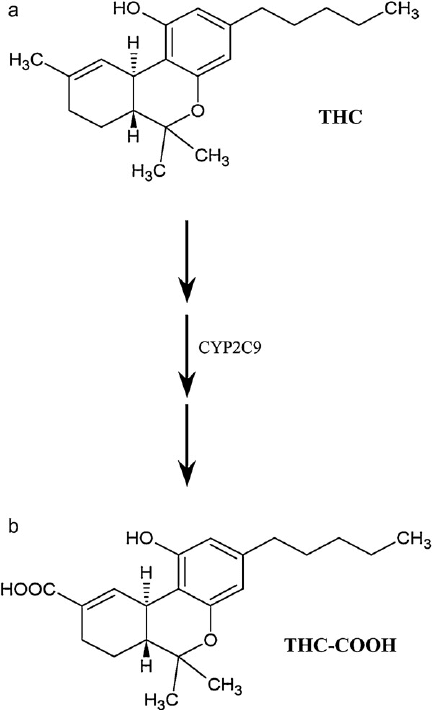
What are the differences between THC and THC-COOH?
THC (tetrahydrocannabinol) and THC-COOH (11-nor-9-carboxy-THC) are two related compounds (the second is a metabolite of the first) but they play different roles in the body and in drug testing. Here are the main differences between the two:
Psychoactive activity
- THC: THC is the main psychoactive compound in cannabis and is responsible for the euphoric, sedative, and psychotropic effects associated with the consumption of the plant.
- THC-COOH: Unlike THC, THC-COOH is non-psychoactive and does not produce psychotropic effects. It is an inactive metabolite of THC that does not interact with the cannabinoid receptors in the brain in the same way that THC does.
Detection in drug tests
- THC: THC is the compound looked for in cannabis screening tests to determine if a person has recently used the substance.
- THC-COOH: Drug tests, such as urine tests, often look for THC-COOH rather than THC itself. This is because THC-COOH has a long half-life in the body and can be detected for a long period of time, sometimes weeks after cannabis consumption.
Metabolism and elimination
- THC: THC is rapidly metabolized in the body and is responsible for the immediate effects of cannabis.
- THC-COOH: THC-COOH is an inactive metabolite that is formed in the THC metabolism process. It accumulates in adipose tissue and is slowly eliminated over time, allowing it to be detected in drug tests long after the effects of THC have worn off.
Function in medical cannabis
- THC: THC is one of the key components of medical cannabis and is used to treat a variety of medical conditions, including chronic pain, nausea, and reduced appetite.
- THC-COOH: Although THC-COOH is important in drug testing, it has no therapeutic applications and is not used in medical treatments.
As you can see, THC is the psychoactive compound in cannabis that produces euphoric effects, while THC-COOH is an inactive (non-psychoactive) metabolite of THC that is used as a marker in tests to detect cannabis consumption. These differences are crucial in terms of effects, detection, and medical application.
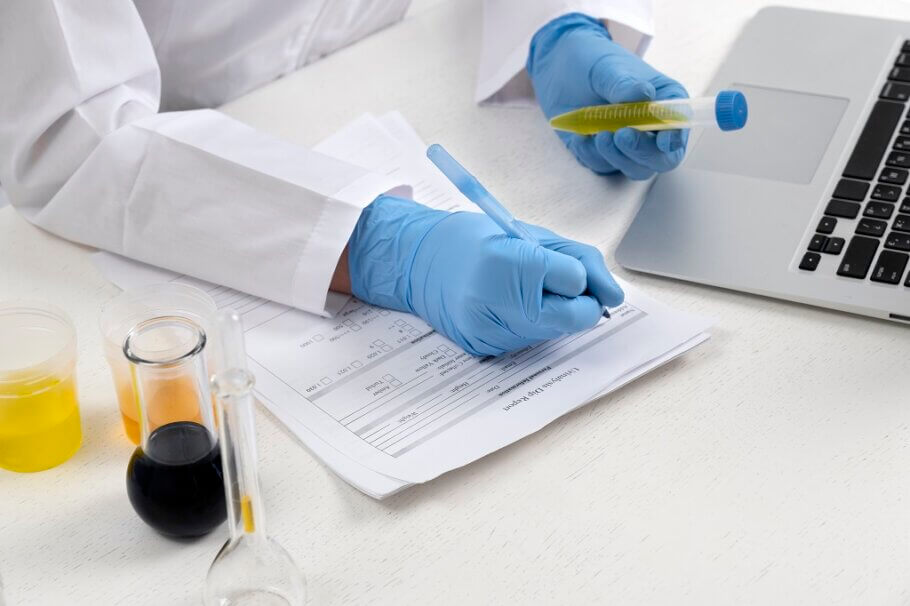
THC-COOH and drug controls
We already know that THC-COOH plays a key role in drug testing, more specifically when it comes to detecting cannabis use in urine. What are the main aspects in which the detection of this compound can be used? We detail some of them:
- Cannabis consumption marker: THC-COOH is an inactive metabolite of tetrahydrocannabinol (THC), the main psychoactive compound in cannabis. After consuming cannabis, the body metabolizes THC into THC-COOH. As a result, the presence of THC-COOH in the body is a clear indication that a person has been exposed to THC through cannabis use.
- Persistence in the body: One of the most important characteristics of THC-COOH is its long persistence in the body. While the psychoactive effects of THC can last for hours, THC-COOH can be detected in the body for a much longer period of time. This means that, through urine or blood tests, it is possible to identify cannabis exposure even weeks after consumption.
- Law Enforcement and Employment Testing: Drug testing, which often looks for THC-COOH, is used in a variety of contexts, including employment, justice, and healthcare. Employers, courts, and healthcare professionals can use these tests to assess whether someone has used cannabis and determine whether they comply with current regulations or policies.
- Medicine and Treatments: In some cases, THC-COOH tests may also have medical applications. Doctors and healthcare professionals may use drug testing, including THC-COOH detection, to assess patients’ adherence to treatments or detoxification programs, as well as to ensure safety in the use of certain medications.
We summarize: THC-COOH is a metabolite of THC that acts as a marker in cannabis consumption detection tests since it allows past exposure to THC to be identified. Its long persistence in the body makes it a valuable tool for law enforcement, the workplace, healthcare, and other contexts where past cannabis use needs to be assessed.
References:
- Solid phase extraction of THC, THC-COOH, and 11-OH-THC from whole blood, Robert M. Sears
- Urinary Elimination of 11-Nor-9-carboxy- 9-tetrahydrocannnabinol in Cannabis Users During Continuously Monitored Abstinence, Robert S. Goodwin, William D. Darwin, C. Nora Chiang, Ming Shih, Shou-Hua Li, Marilyn A. Huestis
- Métodos recomendados para la identificación y el análisis del cannabis y los productos del cannabis, UNODC
The articles published by Alchimiaweb, S.L. are reserved for adult clients only. We would like to remind our customers that cannabis seeds are not listed in the European Community catalogue. They are products intended for genetic conservation and collecting, in no case for cultivation. In some countries it is strictly forbidden to germinate cannabis seeds, other than those authorised by the European Union. We recommend our customers not to infringe the law in any way, we are not responsible for their use.
